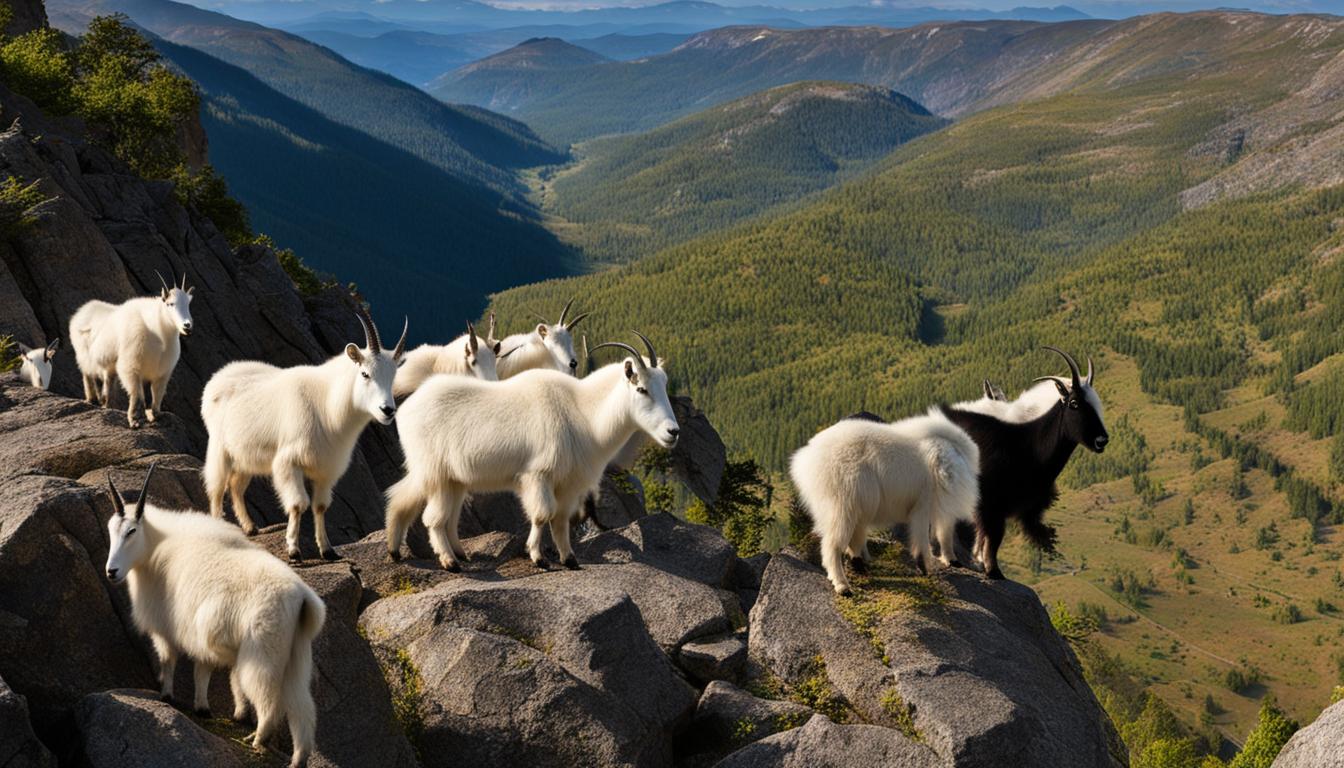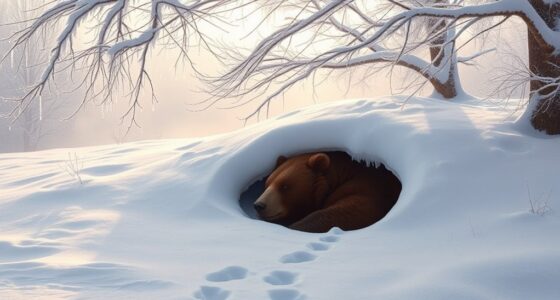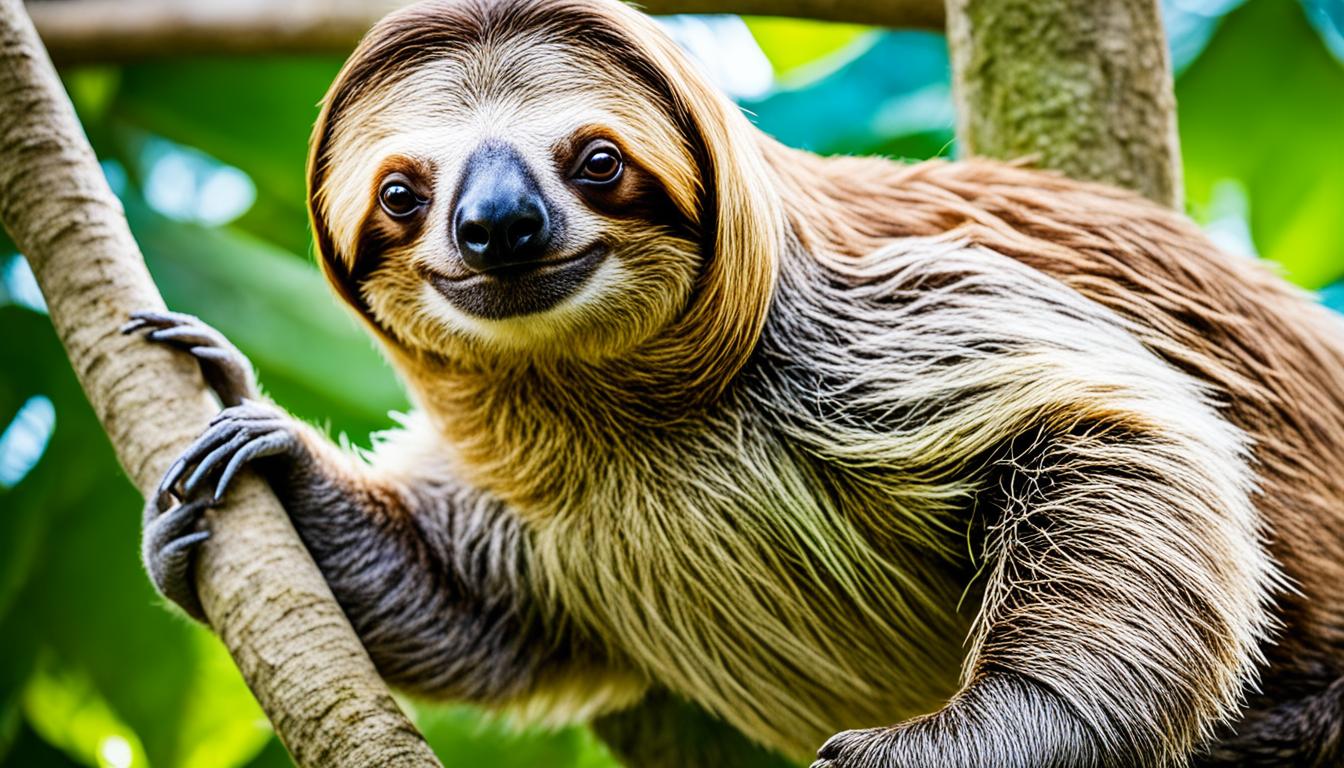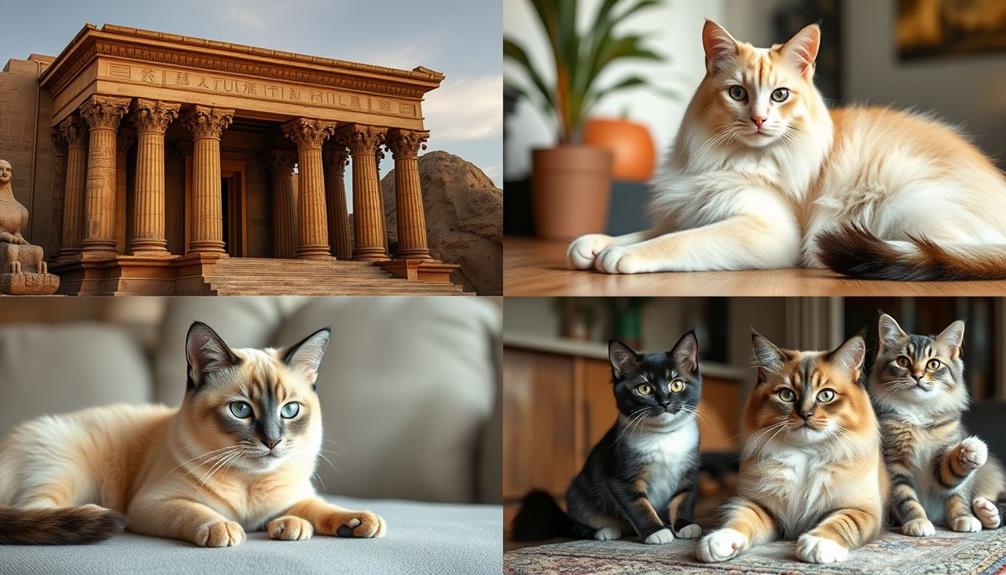During the spring season, more than 100,000 migrating birds return to their breeding grounds in the United States. This amazing occurrence marks the beginning of a lively season filled with life and activity. From singing birds to active mammals, spring showcases a variety of animals coming out of their winter hibernation.
Key Takeaways:
- Spring brings a surge of migrating birds, with over 100,000 returning to the United States.
- The season is characterized by the emergence and activities of various animals after winter hibernation.
- Spring offers opportunities to observe wildlife spectacles, such as badger cubs exploring outside their setts and basking sharks feeding on plankton.
- Children can enjoy observing springtime wildlife, including adorable bunnies, playful hedgehogs, and curious ducklings.
- Spring animals exhibit fascinating behaviors such as mating, nesting, and feeding, essential for their survival and reproduction.
Signs of Spring: Birds, Blooms, and Butterflies
The arrival of spring brings with it a vibrant display of signs that mark the changing season. As the cold grip of winter begins to loosen, nature awakens with the melodious symphony of birdsong, the burst of colors from blooming flowers, and the graceful dance of butterflies. These signs of spring fill the air with joy and anticipation, signaling the start of a new chapter in the natural world.
“The cheerful chorus of nature signals the start of the season.”
Birds play an essential role in announcing the arrival of spring. Their sweet melodies echo through the trees as they sing to attract mates and establish their territories. Each species has its unique song, creating a delightful medley of sounds that fill the fresh spring air. The familiar melodies of robins, sparrows, and blackbirds become a delightful wake-up call, reminding us that warmer days are ahead.
As the days grow longer and the temperature rises, trees and plants burst into life, adorning the landscape with an abundance of blooming flowers. Delicate petals unfurl, revealing stunning colors and captivating scents. Among the first to bloom are flowers like the cuckoo flower and wild daffodils, painting meadows and gardens with their vibrant hues. These early bloomers provide an essential source of nectar for butterflies, including the enchanting orange-tip, as they emerge from their winter slumber.
“Among the first to bloom are flowers like the cuckoo flower and wild daffodils, painting meadows and gardens with their vibrant hues.”
The image above captures the delicate beauty of a butterfly, one of the many creatures that depend on the signs of spring for their survival. These graceful insects flit from flower to flower, sipping nectar and pollinating as they go. Their presence adds an additional layer of magic to the season, as their colorful wings gracefully dance in the sunlight.
“The signs of spring, from birdsong to blooming flowers, are a testament to the resilience and cyclical nature of life. By observing and appreciating these signs, we connect with the rhythms of nature and find ourselves filled with hope and wonder.”
Spring truly comes alive with the signs of birdsong, blooming flowers, and butterflies. The sights and sounds of this season fill our hearts with joy and serve as a reminder of nature’s extraordinary ability to renew itself. As the days grow longer and the world bursts with life, take a moment to pause and appreciate the signs of spring. Let the cheerful chorus of birdsong, the vibrant colors of blooming flowers, and the graceful flight of butterflies inspire you to embrace the beauty and rejuvenation of this remarkable season.
Wildlife Spectacles: From Badgers to Basking Sharks
Spring is a season that brings forth remarkable wildlife spectacles, as animals showcase their behaviors in captivating displays. One such spectacle is the birth of badger cubs in February. By the time mid to late April arrives, these curious young badgers venture outside their setts, exploring the world around them. This adorable sight of playful badger cubs is a true wildlife spectacle that warms the hearts of onlookers.
“Watching badger cubs explore their surroundings is a delightful experience, filled with joy and wonder. It’s a reminder of the magic of spring and the innate curiosity of these young creatures.” – Wildlife enthusiast
Another awe-inspiring wildlife spectacle in spring is the return of basking sharks to the UK’s shores. These magnificent creatures, known as the second-largest fish in the world, make their way back between April and October. As they glide through the waters, basking sharks feed on plankton, creating a mesmerizing display of grace and power.
Witnessing the immense size and gentle movements of basking sharks as they feed is truly a sight to behold, leaving observers in awe of the wonders of the natural world.

These wildlife spectacles of badgers and basking sharks during spring serve as a testament to the beauty and diversity of our planet’s creatures. They captivate and inspire, reminding us of our connection to the natural world.
Spring Migration: The Return of Birds
Spring is a time of incredible movement and excitement in the avian world. As the temperatures rise and the days grow longer, numerous bird species prepare for their long-awaited return to their breeding grounds. This phenomenon, known as spring migration, is a thrilling spectacle that showcases the resilience and instinctual nature of these remarkable creatures.
During spring migration, birds embark on challenging journeys, traveling thousands of kilometers from their wintering grounds to reach their preferred breeding habitats. Species such as swallows and robins undertake arduous flights from Africa to the UK, traversing vast expanses of land and sea. These intrepid travelers navigate by using landmarks, celestial cues, and even Earth’s magnetic field to guide their way.
“Spring migration is a testament to the remarkable navigational abilities and endurance of birds. Witnessing their return is a true wonder of nature.”
The return of migratory birds brings an incredible burst of life and energy to the environment. As they arrive at their breeding sites, the air becomes filled with their melodious songs, marking the end of the long winter and the beginning of a vibrant season. The distinctive calls and vibrant plumage of these returning birds add a colorful touch to the landscape and create a sense of joy and anticipation among nature enthusiasts.
Spring migration is not only a visually stunning experience but also an important ecological event. The arrival of migratory birds is a sign of healthy habitats and functioning ecosystems. These birds play crucial roles in pollination, seed dispersal, and insect control, contributing to the overall balance and biodiversity of their respective habitats.
Observing the return of migratory birds is an opportunity to connect with nature and witness the marvels of the avian world. Whether by visiting birdwatching hotspots, joining guided tours, or simply stepping outside with binoculars in hand, enthusiasts can embark on their own birdwatching adventures. The experience of seeing these aerial travelers returning to their breeding grounds is not only visually captivating but also a humbling reminder of the interconnectedness of all living beings.

Springtime Wildlife for Kids
Spring is an excellent time for children to get acquainted with the wonders of nature. From adorable bunnies and ducklings in meadows to playful hedgehogs and squirrels in gardens, springtime wildlife captivates the hearts of kids.
Getting kids involved in observing and learning about spring animals fosters a sense of wonder and appreciation for the natural world. Here is a list of spring animals that children can interact with:
- Bunnies: Children can spot cute baby bunnies hopping around meadows and fields. These fluffy creatures are a delight to watch as they explore their surroundings.
- Ducklings: Kids can visit ponds and lakes to see fluffy ducklings swimming alongside their parents. It’s a mesmerizing sight to witness these little ones paddling through the water.
- Hedgehogs: Gardens are home to playful hedgehogs. Children can learn about their spiky yet adorable appearance and observe them snuffling around for food.
- Squirrels: Outdoor spaces are bustling with squirrels during springtime. Kids can observe their agile movements as they climb trees and gather nuts.
Encourage your children to spend time in nature and explore the fascinating world of spring animals. These interactions will inspire their curiosity, instill a love for wildlife, and create lasting memories.

Allowing children to connect with springtime wildlife promotes environmental awareness and encourages a deep understanding of the importance of protecting our natural habitats. During this season, kids have the opportunity to witness the beauty and diversity of the world around them.
Fun Facts About Spring Animals
Spring animals are full of fascinating characteristics and behaviors. They possess unique traits that make them intriguing and captivating. Whether it’s their physical abilities or survival strategies, spring animals never fail to impress. Here are some fun facts about these incredible creatures:
Frogs: The Masters of Leaping
Fun Fact: Frogs are known for their exceptional leaping ability. They have muscular hind legs and long, webbed feet that allow them to jump impressive distances. Some species of frogs can leap up to 20 times their own body length! This remarkable skill helps them escape from predators and catch fast-moving prey.
Newts: The Masters of Regeneration
Fun Fact: Newts have an extraordinary ability to regenerate lost body parts. If a newt loses a limb or tail, it can quickly regrow a perfectly functioning replacement. This regenerative power enables newts to survive in their natural habitats and adapt to various challenges. Scientists study newts’ regenerative abilities to gain insights into potential medical advancements.
Butterflies: Nature’s Colorful Gems
Fun Fact: Butterflies are renowned for their vibrant colors and delicate wings. These stunning hues serve various purposes, including attracting mates and warning predators. The colors of butterfly wings are produced by tiny scales that reflect light in a way that creates the stunning patterns we admire. These elegant insects undergo a stunning transformation from caterpillar to butterfly in a process called metamorphosis.
Honeybees: Nature’s Busy Pollinators
Fun Fact: Honeybees are essential pollinators that play a vital role in the reproduction of flowering plants. These tiny insects diligently collect nectar from flowers and unintentionally transport pollen from one flower to another, facilitating cross-pollination. Without the industrious efforts of honeybees, many plant species would struggle to reproduce and thrive.
Hedgehogs: Nature’s Little Gardeners
Fun Fact: Hedgehogs are excellent garden helpers because they feed on common garden pests like slugs and snails. Their spiky exterior serves as a defense mechanism, protecting them from potential predators. Hedgehogs have a fascinating behavior known as “self-anointing,” where they cover themselves in saliva and strange-smelling substances to camouflage their scent.
Image:
 |
Spring Animals in Different Habitats
Spring animals can be found in a variety of habitats, each with its own unique ecosystem. From lush woodland areas where deer gracefully roam to thriving wetlands that are home to frogs and otters, these habitats support a diverse range of spring wildlife. Exploring these different habitats allows nature enthusiasts to observe and appreciate the wonders of the season from a closer perspective.
Woodland areas are a haven for spring animals. Here, one may encounter deer and their adorable offspring, fox cubs, exploring their surroundings while their parents keep a watchful eye. The vibrant green foliage provides a picturesque backdrop as birds chirp melodiously from the treetops.
“The woods would be silent without the enchanting presence of woodland creatures in spring.” – Unknown
Wetlands are another fascinating habitat to explore during the spring season. These vibrant ecosystems come alive with the croaks of frogs as they gather by the water’s edge, engaging in their captivating mating rituals. The sight of otters gracefully gliding through the water is a true testament to the beauty and diversity of wetland habitats.
For those seeking a coastal experience, sandy beaches and rocky shores offer glimpses of spring animals in their natural habitat. Seals basking under the sun, seabirds nesting on towering cliffs, and colorful sea anemones dotting tidal pools create a captivating scene that showcases the resilience of wildlife in a dynamic coastal environment.
Spring Animal Hotspots in Different Habitats
To assist nature enthusiasts in their quest to observe spring animals, here are some popular hotspots known for their abundant wildlife:
- The New Forest, Hampshire: A haven for deer, ponies, and a variety of bird species.
- The Norfolk Broads, Norfolk: A paradise for wetland animals, including otters, frogs, and various bird species.
- The Yorkshire Dales, Yorkshire: Home to red squirrels, hares, and a rich assortment of birdlife.
- The Northumberland Coast, Northumberland: A coastal gem known for its seal colonies, seabirds, and unique marine life.
By exploring these diverse habitats, visitors can witness firsthand the marvelous array of spring animals, each perfectly adapted to their specific ecosystem.

Exploring the habitats of spring animals not only provides an opportunity to appreciate the beauty of nature but also reinforces the need for their conservation. These unique ecosystems are delicate and require preservation to ensure the continued existence of the remarkable species that call them home.
Spring Animal Behavior: Mating, Nesting, and Feeding
As spring blossoms, animals engage in a variety of behaviors crucial to their survival and reproduction. Mating rituals, nest-building, and the search for food dominate the lives of many creatures during this vibrant season. Let’s delve into the fascinating behaviors exhibited by spring animals, exploring their strategies for success.
Mating Rituals
Spring is a time of romance in the animal kingdom, as creatures of all shapes and sizes seek mates to continue their species. From birds displaying elaborate courtship dances to frogs serenading potential partners with melodic calls, the rituals of springtime courtship are a sight to behold. These rituals often involve impressive displays of color, song, or performance to attract a mate. For example, male peacocks proudly flaunt their brilliant plumage while black widow spiders engage in a complex courtship dance.
Nest-Building
With the arrival of spring, many animals start constructing nests to provide a safe haven for their young. Birds meticulously gather twigs, leaves, and feathers to create cozy nests in trees or on the ground, ensuring a warm and secure environment for their eggs. Squirrels, on the other hand, use leaves and branches to fashion intricate nests, called dreys, high up in the trees. Each nest-building process is unique to the species, showcasing their resourcefulness and instinctual drive to protect their offspring.
The Search for Food
Spring marks the awakening of nature’s pantry, offering a bountiful supply of food for animals coming out of hibernation or migration. Insects and flowers, abundant during this time, provide nourishment for creatures both big and small. Butterflies gracefully flutter from flower to flower, sipping nectar with their delicate proboscis, while bears emerge from their winter slumber to forage for berries and fish. Migratory birds take advantage of the seasonal abundance, feasting on insects and building up energy for their long journeys.
Understanding spring animal behavior is a window into the fascinating intricacies of the natural world. It allows us to appreciate the remarkable adaptations and strategies that animals employ to thrive during this vital season.

| Spring Animal Behavior | Examples |
|---|---|
| Mating Rituals | Bird courtship displays, frog serenades, peacock plumage |
| Nest-Building | Bird nests, squirrel dreys |
| The Search for Food | Butterfly nectar feeding, bear foraging, bird migration |
Spring Animal Sightings: Tips for Wildlife Watching
Watching spring animals in their natural habitats can be a rewarding experience. Whether you’re an avid wildlife enthusiast or simply enjoy being in nature, observing spring animals can provide a unique glimpse into their world. To make the most of your wildlife watching adventures, here are some practical tips and guidelines to keep in mind during the spring season:
- Research and Plan: Before heading out, do some research on the types of spring animals you are likely to encounter in your area. Learn about their habitats, preferred locations, and behaviors to increase your chances of spotting them.
- Timing is Key: Different animals are active at different times of the day. Some may be more active during early morning or late evening hours, while others may be easier to spot during the midday. Plan your wildlife watching outings accordingly to maximize your chances of seeing animals in action.
- Be Patient: Wildlife watching requires patience. Find a comfortable spot, stay still, and quietly observe your surroundings. Avoid making sudden movements or loud noises that might scare away the animals.
- Binoculars and Cameras: Equip yourself with binoculars or a camera with a zoom lens to get a closer look at the animals without disturbing them. However, remember to prioritize experiencing the moment firsthand rather than focusing solely on capturing the perfect shot.
- Respect their Space: Remember that you are a visitor in their habitat. Keep a safe distance from the animals and observe them from afar. Avoid getting too close, touching, or feeding them as it can disrupt their natural behaviors and health.
- Be Mindful of the Environment: While exploring wildlife habitats, make sure you adhere to the principles of Leave No Trace. Do not litter, stay on designated paths, and avoid damaging plants or disturbing nesting areas.
- Stay Safe: Wildlife watching can be adventurous, but safety should always be a priority. Be aware of potential hazards such as uneven terrain, extreme weather conditions, or encounters with larger animals. Familiarize yourself with safety guidelines and precautions specific to your location.
- Join Guided Tours or Workshops: If you’re new to wildlife watching or want to enhance your skills, consider joining guided tours or workshops led by knowledgeable experts. These experiences can offer valuable insights, expert guidance, and the opportunity to connect with like-minded individuals.
- Keep a Journal: Document your sightings, observations, and the overall experiences in a nature journal. This allows you to create lasting memories and contribute to citizen science initiatives by reporting your sightings to relevant organizations.
By following these tips, you can make the most of your spring wildlife watching adventures and foster a deeper appreciation for the wonders of the natural world. So grab your binoculars, head out into nature, and prepare to be amazed by the incredible spring animal sightings that await you.
Conservation and Protection of Spring Animals
As spring animals emerge and play their roles in the ecosystem, it becomes essential to focus on their conservation and protection. By preserving their habitats and reducing human impact, we can ensure the long-term survival of our spring wildlife. Additionally, creating awareness about the value of these animals in maintaining biodiversity is crucial for their continued existence.
Conservation efforts play a vital role in safeguarding the habitats and populations of spring animals. Organizations such as the Wildlife Conservation Society and the National Wildlife Federation work diligently to protect and restore habitats, advocate for policy changes, and engage communities in conservation initiatives.
“Conservation is a race against time. We need urgent action to protect our precious spring animals and the ecosystems they depend on.”
To actively contribute to the well-being of spring animals, individuals can take various actions. Here are some practical steps you can take to make a difference:
- Support local conservation organizations through donations or volunteering.
- Create a wildlife-friendly garden by planting native flowers and providing sources of food and water.
- Reduce the use of pesticides and chemicals in your garden to protect pollinators and other beneficial spring animals.
- Advocate for stronger environmental policies and regulations that prioritize the protection of wildlife habitats.
- Participate in citizen science projects that monitor and track spring animal populations.
Remember, every small action counts when it comes to the conservation and protection of spring animals. Together, we can make a positive impact and ensure that future generations can continue to enjoy the beauty and diversity of our natural world.
Conservation Organizations
Here are some notable organizations dedicated to the conservation and protection of spring animals:
| Organization | Description |
|---|---|
| Wildlife Conservation Society | The Wildlife Conservation Society works to conserve wildlife and ecosystems around the globe, focusing on science, education, and community engagement. |
| National Wildlife Federation | The National Wildlife Federation is one of America’s largest conservation organizations, committed to protecting wildlife and habitats through education, advocacy, and on-the-ground conservation efforts. |
| World Wildlife Fund | The World Wildlife Fund is a leading international conservation organization that works to protect endangered species and their habitats through a combination of fieldwork, scientific research, and policy advocacy. |
By supporting these organizations and taking individual actions, we can contribute to the conservation and protection of spring animals, ensuring their survival for generations to come.
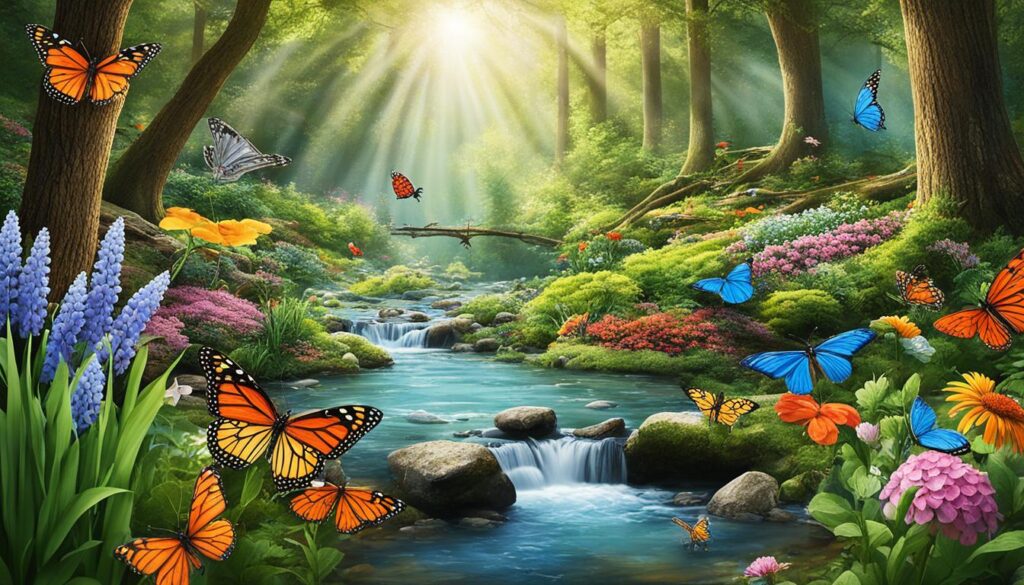
Conclusion
Spring is a magical season where nature bursts into life, and spring animals take center stage. From the energetic playfulness of badger cubs exploring the world around them to the mesmerizing dances of great crested grebes on shimmering lakes, spring wildlife captivates our hearts and reminds us of the wonders of the natural world.
By cherishing and protecting spring animals, we not only ensure the continuation of their existence but also preserve the delicate balance of our ecosystems. Through conservation efforts and raising awareness, we can safeguard the habitats they rely on and reduce human impact on their survival. By doing so, we create a brighter future for both spring animals and future generations who will inherit our planet.
So, the next time you hear the joyful melodies of singing birds or spot a newborn fawn in a meadow, remember the vital role they play in maintaining biodiversity. Take a moment to appreciate their beauty and resilience, and consider what you can do to protect them. Together, we can make a difference and ensure that the enchantment of spring and its remarkable animals continue to inspire awe and wonder for years to come.

